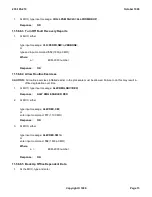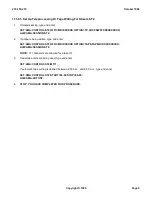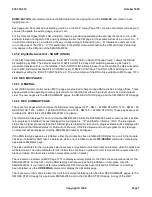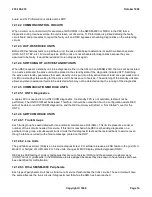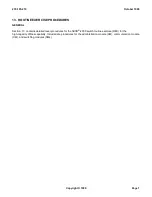
If the diagnostic fails during REX, and only during REX, the failure message along with the TLP will print out.
The message (format defined below) STF RETRY TO FOLLOW will print, then a retry will be done beginning
with the first phase. If the diagnostics (C)ATP on the retry, the diagnostics will be run one more time to verify the
failure.
If the diagnostics (C)ATP on both of these retries, the circuit/unit will then be restored to service. If the
diagnostic fails during either of the retries, the failure will print out along with the TLP, and the circuit/unit will be
considered faulty and will be left OOS. The failure message that will be printed when a retry is going to be done,
will have the following format:
DGN
xyz
=
a
COMPLETED STF RETRY TO FOLLOW
Where:
xyz
is the circuit/unit being diagnosed and
a
is the circuit/unit number.
NOTE:
Due to the severity of type of diagnostic failure, some failures may not cause a retry to be done;
therefore, if the diagnostic fails, it will stop, no retry done, and the circuit/unit will be left OOS.
Partial diagnostic (SWITCH):
SWITCH results in a soft switch of the communication module processor
(CMP), the pump peripheral controller (PPC), the foundation peripheral controller (FPC), and the office network
and timing complex (ONTC). No diagnostics are executed.
In the SM/SM-2000, three test types can be specified. They are as follows:
Full diagnostic (DGN):
A full diagnostic results in a conditional restore request including the trouble location
procedure (TLP) option. A conditional restore consists of: a remove of the target unit/circuit, a full diagnostic on
the unit/circuit, and a restore of the unit/circuit to service if the diagnostic result was all tests pass (ATP) or
conditional all tests pass (CATP).
If the diagnostic fails during REX, and only during REX, the failure message along with the TLP will print out.
The message (format defined below) STF RETRY TO FOLLOW will print, then a retry will be done beginning
with the first phase. If the diagnostics (C)ATP on the retry, the diagnostics will be run one more time to verify the
failure. If the diagnostics (C)ATP on both of these retries, the circuit/unit will then be restored to service. If the
diagnostic fails during either of the retries, the failure will print out along with the TLP, and the circuit/unit will be
considered faulty and will be left OOS or put in the degraded state. The failure message that will be printed
when a retry is going to be done, will have the following format:
DGN xyz=a COMPLETED STF RETRY TO FOLLOW
Where:
xyz
is the circuit/unit being diagnosed and
a
is the circuit/unit number.
NOTE:
Due to the severity of type of diagnostic failure, some failures may not cause a retry to be done;
therefore, if the diagnostic fails, it will stop, no retry done, and the circuit/unit will be left OOS or
degraded.
Fabric exerciser (FAB):
The FAB tests the operation of the gated diode crosspoints (GDX) in the line unit (LU)
concentrator grids and grid boards. It requests a path to each crosspoint to be tested by calling peripheral
control (PC) path hunt routines. A series of tests are then performed on the crosspoint and its associated path
using a high-level service circuit (HLSC).
Electronic loop segregation (ELS):
ELS tests customer lines to determine a suitable network balance
necessary to reduce the amount of potential echoing in the transmission path. Office data is updated, as
needed, storing the proper balance network value to be used in call setup.
The following comments apply to both CM and SM/SM-2000 diagnostics. A global parameter can be modified using
235-105-210
October 1999
Copyright © 1999
Page 2
Summary of Contents for 5ESS-2000
Page 96: ...235 105 210 October 1999 Copyright 1999 Page 2 ...
Page 184: ...235 105 210 October 1999 Copyright 1999 Page 3 ...
Page 300: ...13 STOP YOU HAVE COMPLETED THIS PROCEDURE 235 105 210 October 1999 Copyright 1999 Page 55 ...
Page 339: ...7 STOP YOU HAVE COMPLETED THIS PROCEDURE 235 105 210 October 1999 Copyright 1999 Page 13 ...
Page 342: ...235 105 210 October 1999 Copyright 1999 Page 2 ...
Page 359: ...235 105 210 October 1999 Copyright 1999 Page 5 ...
Page 609: ...2 STOP YOU HAVE COMPLETED THIS PROCEDURE 235 105 210 October 1999 Copyright 1999 Page 12 ...
Page 676: ...235 105 210 October 1999 Copyright 1999 Page 9 ...
Page 792: ...3 STOP YOU HAVE COMPLETED THIS PROCEDURE 235 105 210 October 1999 Copyright 1999 Page 9 ...
Page 799: ...Figure 11 36 3 1 Cleaning Points 235 105 210 October 1999 Copyright 1999 Page 7 ...
Page 801: ...235 105 210 October 1999 Copyright 1999 Page 9 ...
Page 839: ...2 STOP YOU HAVE COMPLETED THIS PROCEDURE 235 105 210 October 1999 Copyright 1999 Page 16 ...
Page 999: ...2 STOP YOU HAVE COMPLETED THIS PROCEDURE 235 105 210 October 1999 Copyright 1999 Page 13 ...
Page 1008: ...Figure 11 55 1 CTSNS DIP Switch Settings 235 105 210 October 1999 Copyright 1999 Page 2 ...
Page 1011: ...235 105 210 October 1999 Copyright 1999 Page 5 ...
Page 1053: ...235 105 210 October 1999 Copyright 1999 Page 15 ...
Page 1289: ...Figure 15 17 2 AMATPS Data Link 235 105 210 October 1999 Copyright 1999 Page 2 ...
Page 1292: ...235 105 210 October 1999 Copyright 1999 Page 5 ...
Page 1303: ...9 STOP YOU HAVE COMPLETED THIS PROCEDURE 235 105 210 October 1999 Copyright 1999 Page 2 ...
Page 1360: ...Figure 15 47 2 Typical SCANS III Link Diagram 235 105 210 October 1999 Copyright 1999 Page 2 ...
Page 1372: ...235 105 210 October 1999 Copyright 1999 Page 2 ...
Page 1374: ...235 105 210 October 1999 Copyright 1999 Page 4 ...
Page 1421: ...Table 1 1 O M Checklist 235 105 210 October 1999 Copyright 1999 Page 3 ...


